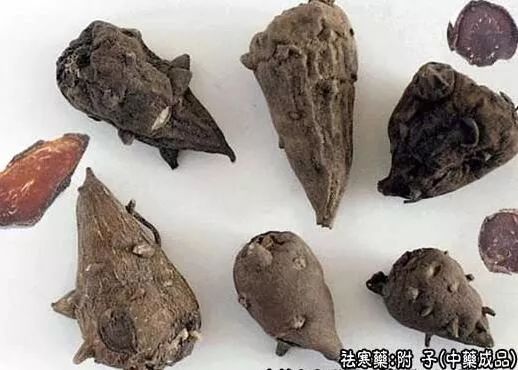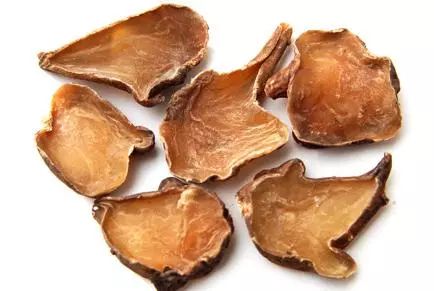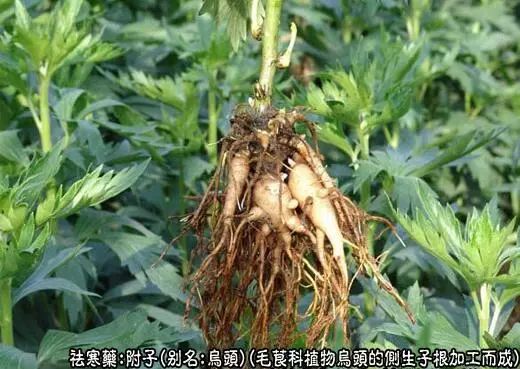
Fu Zi
Fu Zi, a name in traditional Chinese medicine, is a processed product of the tuberous root of the plant Aconitum carmichaelii Debx, belonging to the Ranunculaceae family. It is harvested from late June to early August, with the mother root, fibrous roots, and soil removed, commonly referred to as “mud Fu Zi”. It is distributed in regions such as Sichuan, Shaanxi, Guizhou, Hunan, Hubei, Gansu, Yunnan, Guangxi, Jiangxi, and Anhui. It has the effects of reviving Yang, supporting fire, dispelling cold, and alleviating pain. It is used for symptoms such as Yang collapse, cold limbs with weak pulse, insufficient heart Yang, chest obstruction and heart pain, cold and deficient vomiting and diarrhea, cold abdominal pain, kidney Yang deficiency, impotence, cold water retention, Yang deficiency with external pathogens, and cold dampness causing pain.
Fu Zi Images

Fu Zi Images

Fu Zi Images

Fu Zi Images
Introduction to Fu Zi
Herb Name: Fu Zi
Pinyin: Fù Zǐ
Alias: Fu Pian, Yan Fu Zi, Hei Shun Pian, Bai Fu Pian
Source: This product is a processed product of the tuberous root of the plant Aconitum carmichaelii Debx. It is harvested from late June to early August, with the mother root, fibrous roots, and soil removed, commonly referred to as “mud Fu Zi”, and processed into the following varieties.
(1) Select large, uniform mud Fu Zi, wash it, soak it in a solution of edible gallbladder overnight, then add salt and continue soaking, taking it out daily to dry, gradually extending the drying time until a large number of crystalline salt particles (salt frost) appear on the surface of Fu Zi, and the texture becomes hard, commonly referred to as “salt Fu Zi”.
(2) Take mud Fu Zi, wash it according to size, soak it in a solution of edible gallbladder for several days, boil it with the soaking liquid until thoroughly cooked, remove it, rinse with water, cut it into slices about 0.5 cm thick, then soak in water, dye the slices with a coloring solution to a dark tea color, steam until an oily surface and gloss appear, then dry or continue to dry, commonly referred to as “black shun slices”.
(3) Select uniform-sized mud Fu Zi, wash it, soak it in a solution of edible gallbladder for several days, boil it with the soaking liquid until thoroughly cooked, remove the outer skin, cut it into slices about 0.3 cm thick, soak in water, steam until cooked, and dry, commonly referred to as “white Fu slices”.
Characteristics: Salt Fu Zi: conical shape, 4-7 cm long, 3-5 cm in diameter. The surface is gray-black, covered with salt frost, with a depressed bud scar at the top and tuberous protrusions or scars around it. It is heavy, with a gray-brown cross-section, small voids filled with salt frost, and irregularly arranged vascular bundles in the annular pattern. It has a faint odor, a salty and numbing taste, and a prickly sensation on the tongue.
Black shun slices: longitudinally cut slices, wider at the top and narrower at the bottom, 1.7-5 cm long, 0.9-3 cm wide, and 0.2-0.5 cm thick. The outer skin is black-brown, the cut surface is dark yellow, oily and glossy, semi-transparent, with longitudinal vascular bundles. It is hard and brittle, with a horn-like fracture surface. It has a faint odor and a bland taste.
White Fu slices: no outer skin, yellow-white, semi-transparent, about 0.3 cm thick.
Chemical Components: Contains alkaloids, including aconitine, new aconitine, and mesaconitine, among others. Additionally, it contains non-alkaloid components.
Taste and Properties: Spicy, sweet, and very hot in nature.
Meridians Entered: Heart, Kidney, and Spleen meridians.
Storage: Salt Fu Zi should be stored in a sealed container in a cool, dry place; black shun slices and white Fu slices should be stored in a dry place to prevent moisture.
Contraindications: Contraindicated for those with Yin deficiency and Yang excess, true heat and false cold, and pregnant women. It should not be used with Ban Xia, Gua Lou, Gua Wei Zi, Gua Lou Pi, Tian Hua Fen, Chuan Bei Mu, Zhe Bei Mu, Ping Bei Mu, Yi Bei Mu, Hu Bei Bei Mu, Bai Lian, and Bai Ji.
Functions of Fu Zi
Revives Yang, supports fire, dispels cold, and eliminates dampness. It treats Yin excess obstructing Yang, excessive sweating leading to Yang collapse, vomiting and diarrhea with counterflow, cold pain in the heart and abdomen, spleen leakage with cold dysentery, edema in children with Beriberi, wind-cold-damp obstruction, spasms and contractions, impotence, cold in the womb, sores and ulcers, and all diseases of deep cold and stubborn cold.
Actions of Fu Zi
This herb has long been considered to have the effects of reviving Yang and alleviating pain. Its pharmacological effects have now been confirmed as follows:
1. Cardiotonic. It can enhance the heart’s contractile force. In cases of counterflow (shock, heart failure), Fu Zi’s cardiotonic effect improves overall circulation, thus treating cardiovascular insufficiency. The effective component is the non-alkaloid part, which is generally not destroyed by pre-boiling and retains its cardiotonic effect.
2. Analgesic. Experiments have shown that the decomposition products of aconitine have a certain analgesic effect.
3. Anti-inflammatory. It has a significant anti-inflammatory effect on experimental arthritis (formaldehyde and egg white induced).
4. Stimulates the pituitary-adrenal cortex system. The decoction of cooked Fu slices significantly reduces the content of ascorbic acid in the adrenal glands of rats, increases the excretion of 17-ketosteroids in urine, and reduces the number of eosinophils in peripheral blood. Additionally, for some patients with adrenal cortical insufficiency, Fu Zi has adrenal cortical hormone-like effects.
Dosage of Fu Zi
Internal use: 3-15 g. — “Chinese Pharmacopoeia”
Internal use: decoction, 1-3 qian; or in pills or powders. — “Dictionary of Chinese Medicine”
External use: ground into powder for application. — “Dictionary of Chinese Medicine”
Fu Zi Formulas
Note: The following formulas should be used under the guidance of a physician.
① For treating vomiting and diarrhea, sweating, fever with chills, and cold extremities:
Two liang of licorice (roasted), one and a half liang of dried ginger, one piece of Fu Zi (raw, peeled, broken into eight pieces). Combine these three ingredients, boil with three sheng of water until one sheng and two ge remain, strain, and take warm. Strong individuals may use one piece of large Fu Zi and three liang of dried ginger. (“Treatise on Febrile Diseases” Si Ni Decoction)
② For treating cold damage with Yin excess, where the person is agitated and does not want to drink water:
One piece of large Fu Zi burned to ash, retain the essence, and take as powder with honey water. (“Secret Treasure of the Family” Pili San)
③ For treating Yin toxin cold damage, with a pale face, cold extremities, abdominal pain, and cold body:
Three pieces of large Fu Zi (processed, peeled) as powder. Each dose is three qian, mixed with half a cup of ginger juice and half a cup of cold wine. Take until warmth is felt below the navel. (“Jisheng Fang” Hui Yang San)
④ For treating cold damage that has already turned downward, with excessive sweating, internal and external deficiency, evil qi unresolved, no major heat during the day, restlessness, inability to sleep, quiet at night, no vomiting or thirst, and a weak pulse:
One liang of coarse ground dried ginger, one piece of Fu Zi (raw, peeled, finely sliced). Mix well. Each dose is three qian, boiled with one and a half cups of water until one cup remains, strain and take warm before meals. (“Jufang” Jiang Fu Decoction)
⑤ For treating vomiting and counterflow:
One large Fu Zi and one ginger (finely shredded). Boil and grind into a paste, take with rice drink. (“Experience Formulas”)
⑥ For treating all heart pain, small intestine, and bladder pain that cannot be stopped:
One liang of Fu Zi (processed), one liang each of curcuma and tangerine peel. Grind into powder, mix with vinegar to form pills the size of sour jujube. Each dose is one pill, taken with wine for men and vinegar soup for women. (“Xuanming Lun Fang” Chen Sha Dan)
Warm Reminder:Use medication with caution, please follow medical advice!
Learn about Chinese herbs in just 5 minutes a day and pursue a healthy diet!
If you would like to learn about a specific Chinese herb, you can long-press the QR code below to follow this account (Chinese Herbs and Healthy Diet, WeChat ID: zycydq ), and then directly input the name of the herb (for example, honeysuckle) in the dialogue box to query. Our database includes over 5000 common Chinese herbs, and we welcome your suggestions. Thank you.

▲ Long press the QR code to “recognize” and follow


